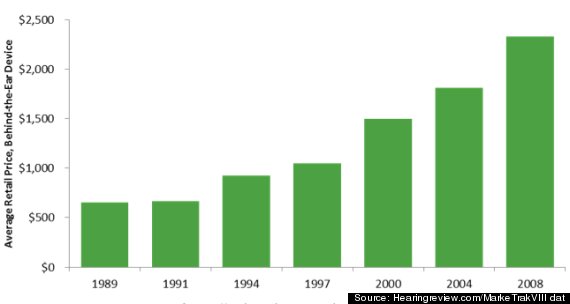The healthcare industry is failing to address a massive, treatable epidemic.
36 million Americans suffer from hearing loss, a number that is only increasing as the population ages. Hearing loss has been linked to chronic disease, depression and even reduced earnings, and the health benefits of treatment are clear, with studies showing that hearing aids profoundly improve quality of life, and can even prevent brain atrophy. Nonetheless, the hearing care industry seems content with a status quo characterized by inflated costs and low adoption, in effect turning a deaf ear toward untreated hearing loss.
America's hearing aid market is broken.
Given the benefits, a consumer might reasonably expect the free market to provide a selection of affordable hearing aid options. That consumer would be sorely disappointed. Today you can walk into an Apple store and take home an iPhone for $650, but if you want to buy hearing aids you'll have to shell out around $5,000. To put this number in perspective, Apple spent about 23 times as much on research and development last year as William Demant, the manufacturer of Oticon hearing aids. Hearing aid adoption has stagnated around 25% for years and increasingly high prices have surely played a role.

Taken together, restricted adoption and elevated prices are the hallmarks of monopoly. In the case of hearing aids, the monopoly was created by state-level regulations designed to protect consumers. Before an individual can purchase a hearing aid, a hearing test must be administered by a professional trained to recognize potentially serious health conditions. No one would object to the importance of this examination, but it's critical to realize that many audiologists are also hearing aid salespeople and that regulation has effectively handed them the deed to a cornered market.

The choices audiologists present to consumers are almost invariably stark: Break the bank for the sake of your health or live with an untreated disability. Neither option is particular attractive.
Since consumers can't choose to buy elsewhere, the industry gets away with making consumers pay through the nose while obfuscating the true price of hearing aids by "bundling" the devices in a "package" that includes unlimited follow-up care. From the industry's perspective, this is a very smart pricing strategy because it "captures" customers and makes them "sticky." Once the customer purchases a service package, he is effectively "locked in" and is unlikely to switch providers.
Professionals also benefit from asymmetric information in pricing the service package: They have a very good idea how much follow-up care the customer is likely to need, while a first-time hearing aid buyer probably doesn't.
From the perspective of the less-informed consumer, the medical purpose of the device may seem to justify a $5,000 price tag. What the customer may not realize is that he is really paying for a $2,000 device with a $3,000 service package attached. Trying to sell a service package at a cost of $300 per visit wouldn't be easy in a competitive marketplace, but as part of the "package" of care, that's often how the math works out.
In private conversations, some audiologists admit that "unbundling" is inevitable and that the value of audiologic care must eventually drive pricing. A recent article in Hearing Review even suggests "unbundling" as potential way to increase adoption. This will be a painful adjustment for the industry and Audiologists typically object to nontraditional sales channels, noting that expert professional service can mean the difference between successful hearing aid adoption and hearing aids ending up in a drawer.
Because their concern is not unreasonable, the question becomes: What if a consumer saves thousands of dollars by buying hearing aids online then negotiates after-market support from a local audiologist to maintain a high standard of care?
The answer is clear. The audiologist no longer pockets the retail mark-up and the consumer saves thousands of dollars. The audiologist may recoup some of his lost revenue by selling an after-market service package, but will lose out overall.
In the future, it seems likely that manufacturers will make hearing aid programming technology available directly to consumers, giving savvy technophiles the choice to bypass audiologic "re-programmings" altogether. But the first manufacturer to do so would likely face swift reprisals, and soon find its audiologist distributors pushing competitors' products. Since this seems unlikely, the short term focus needs to be on unbundling hearing care.
Audiologists may fear that 1-800 Contacts' effect on optometrists could be replicated in the cash cow hearing aid market, but this nightmare scenario would offer an affordable alternative to the 27 million Americans with untreated hearing loss. With an unsound market offering a deal this raw, it is only a matter of time until the status quo gets shattered. The coming change is long overdue. Better late than never.
---
Sam Tanzer is the CEO of Embrace Hearing, an online hearing aid retailer that aims to improve the lives of the millions Americans with untreated hearing loss.